Thesis Chapters-ANN by Taha A L F A D U L Taha Ali
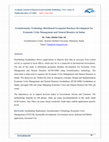
Academic Journal of Research and Scientific Publishing| AJRSP(2706-6495), 2022
Distributing Geodatabase allows organizations to disperse their data as necessary from central se... more Distributing Geodatabase allows organizations to disperse their data as necessary from central servers to regional or local offices, which may be in a connected or disconnected environment. The aim of this study is distributed geospatial database development For Economic Crisis Management and Natural Disasters (ECM-GDB) using Geoinformatics technology. The motivation is deep need to organize the Economic Crisis Management and Natural Disasters in Sudan. The objectives are: Define the crisis & emergency concepts, Design and implementation Economic Crisis Management and Natural Disasters Geodatabase (ECM-GDB) Geodatabase in Sudan, and apply GIS call center Managing Economic Crises and Natural Disasters the GIS call center. The importances are to support decision maker in Government, Society and Customer. The methodology depends on GIS phases. There are many recommendations of this study: build ECM System. Also There are many future researches: build many mobile applications specific ECM.
Asian Basic and Applied Research Journal 5(4): 12-15, 2022;Article no.ABAARJ.923, 2022
Abstract
This paper analyzes the shortcomings of previous approaches in renewable energ... more Abstract
This paper analyzes the shortcomings of previous approaches in renewable energy using GIS Modeling, Multi Criteria Model, and Sustainable Model. Geospatial has become decision Support Maker, and how to enable sustainable energy efforts. Multi-criteria modeling in Geospatial has proven useful for locating optimal areas.
We are currently essential trends: GIS Modeling, Multi Criteria Model, and Sustainable Model. And future research Geospatial renewable energy research: Decentralization Data Storage, Sensor data via internet of things(IoT), Big Data, BlockChain, 3D Building Models, CyberSecurity, Geospatial 3D Analysis, and Geovisualization.
Keywords: GIS; Sustainable and Smart city; Geospatial Analysis.
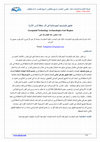
Academic Journal of Research and Scientific Publishing| AJRSP(2706-6495), Dec 10, 2022
المستخلص: إن تطورمجال نظم المعلومات الجغرافية والاستشعار عن بعد، ساهم مساهمة كبيرة في تطور واك... more المستخلص: إن تطورمجال نظم المعلومات الجغرافية والاستشعار عن بعد، ساهم مساهمة كبيرة في تطور واكتشاف العديد من المعالم الأثرية، لذلك نجد دراستنا تناقش توثيق المعالم المكانية الأثريةلمنطقة قري، السودان باستخدام نظم المعلومات الجغرافية والاستشعار عن بعد، حيث نجد أن قلة في المعلومات الوصفية والمكانية للمعالم الأثريةلمنطقة قري، إضافة الي عدم وجود تطبيق معلوماتي متكامل يسهم في توثيق هذه المعالم وتطويرها من خلال دعم متخذي القرار. إن أهداف الدراسة تتمثل في جمع وتصنيف البيانات والمعلومات المكانية والوصفية للمعالم الأثريةلمنطقة قري، تصميم قاعدة البيانات المكانية للمعالم المكانية الأثريةلمنطقة قري، تنفيذ تطبيق جغرافي مكاني للمعالم المكانية الأثريةلمنطقة قري، إنتاج خريطة المعالم المكانية الأثريةلمنطقة قري. اتبعت الدراسة المنهج الوصفي الميداني التطبيقي. توصلت الدراسة الي العديد من النتائج من أهمها:تم تسجيل وحصرحوالي 20 موقع أثري بمنطقة قري حيث تعود لفترات تاريخية مختلفة منذ العصور الحجرية حتي الفترة الإسلامية. تشمل مواقع استيطانية – مقابر- كنائس. هذا التنوع والثراء في المواقع يوضح ان منطقة قري ظلت معاصرة كل الفترات الأثرية في السودان، (( عصور حجرية (300.00- 3700ق م) 8 معالم، مابعد مروي (من القرن الربع الميلادي - القرن السادس الميلادي) 4 معالم، الفترة المسيحية ( منصف القرن السادس الميلادي – 1504 م) 4 معالم، الفترة الاسلامية (1505 – 1820 م) 5 معالم، و 2 معلم غير محدده)). تم بناء قاعدة البيانات المكانية للمعالم المكانية الأثريةلمنطقة قري، تنفيذ تطبيق جغرافي مكاني للمعالم المكانية الأثريةلمنطقة قري، تم إنتاج العديد من الخرائط والمعالم المكانية الأثرية لمنطقة قري(خريطة لجميع المعالم، في العصر الحجري، الفترة ما بعد مروي، الفترة المسيحية، الفترة الاسلامية، الفترة غير محددة)، توصي الدراسة بتصميم تطبيق ويب وموبايل لدعم متخذ القرار، وارشادي للسائح، كما توصي باعداد دراسة مستقبلية لتطبيق ثلاثي الابعاد للمنطقة.
الكلمات المفتاحية : نظم المعلومات الجغرافيةالأثرية (Archeology Geographic Information System-AGIS)، قاعدة البيانات الجغرافية الأثرية (Archeology Geodatabase-AGDB)، تطبيقات الجيومعلوماتية Geoinformatics Application
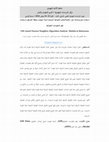
The First International Conference on Mahdism Scientific Studies, University Of El Imam El Mahdi, 2016
المستخلص: تتناول الورقة استخدام خوارزمية صلة جوار لتحليل المعالم الجغرافية التاريخية لدولة المهدي... more المستخلص: تتناول الورقة استخدام خوارزمية صلة جوار لتحليل المعالم الجغرافية التاريخية لدولة المهدية بمدن ولاية الخرطوم باستخدام نظم المعلومات الجغرافية، حيث تمثلت مشكلة الورقة في قلة الدراسات التي تربط بين مجالات تقانة المعلومات والتاريخ السوداني، وقلة المعلومات الخاصة بالمعالم الجغرافية التاريخية لدولة المهدية بولاية الخرطوم، وعدم وجود تحليل جغرافي للمواقع الجغرافية التاريخية بدولة المهدية. كما تتمثل أهمية الورقة في توضيح أهمية نظم المعلومات الجغرافية ودورها في التحليل الجغرافي وتقييم للمعالم التاريخية لدولة المهدية. كما تتمثل أهداف الورقة في جمع وتصنيف المعالم الجغرافية التاريخية لدولة المهدية بولاية الخرطوم، بناء نموذج تحليل صلة الجوار الجغرافي للمعالم الجغرافية التاريخية لدولة المهدية بولاية الخرطوم، تقييم نمط التوزيع الجغرافي للمعالم الجغرافية التاريخية لدولة المهدية بولاية الخرطوم. سوف يتم استخدام المنهجية التحليلية الوصفية المتمثلة في التحليل والتصميم والتطبيق. توصلت الورقة الي العديد من النتائج من أهمها: بناء نموذج تحليل صلة الجوار للبيانات الجغرافية للمعالم الجغرافية التاريخية لدولة المهدية بولاية الخرطوم، تقييم نمط التوزيع الجغرافي للمعالم الجغرافية التاريخية لدولة المهدية بولاية الخرطوم. كما توصي الورقة الي العديد من التوصيات من أهمها: جمع وتصنيف المعالم الجغرافية التاريخية لدولة المهدية بالسودان، بناء نموذج التحليل المكاني للبيانات الجغرافية للمعالم الجغرافية التاريخية لدولة المهدية بالسودان، تقييم واقع التوزيع الجغرافي للمعالم الجغرافية التاريخية لدولة المهدية بالسودان. ومن أهم التوصيات المستقبلية للورقة تحليل انماط التوزيع الجغرافي لجميع المعالم الجغرافية التاريخية لدولة المهدية بالسودان.
مفتاح الكلمات: نظم المعلومات الجغرافية(GIS)، الدولة المهدية، نموذج البيانات الجغرافي(GIS Data Model)، تحليل صلة الجوار(ANN).
The 21th Int'l Conf on Image Processing, Computer Vision, & Pattern Recognition, CSCE’17,American Council On Science and Education, Las Vegas, Nevada, USA, July 17-20,2017., 2017
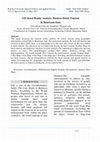
Red Sea University Journal of Basic and Applied Science(JBAS), 2017
This paper discusses the tourism reality analysis for hotels tourism using geographic information... more This paper discusses the tourism reality analysis for hotels tourism using geographic information system(GIS) in Khartoum state. The motivation includes the lack information and research in these fields, there is no knowledge serve the tours and visitors or decision makers in hotel tourism. The objectives are to Collect and classify the hotel tourism, Product Maps for hotel tourism, and Statistical Analysis for hotel tourism. The importance's support the decision makers or tours. The methodologies include three phase: Analysis, Design and Implementation. The results include, first: Classify the hotel tourism, second: Product Maps : 5-Star Map, 4-Star Map, 3-Star Map, 2-Star Map and 1-Star Map, and third Statistical Analysis for hotel tourism. The recommendations Classify the hotel tourism and spatial analysis in Sudan, Developments the geographic distribution for hotel tourism in Sudan, and Distribute the hotel tourism in Sudan according the service tourism tours.
Keywords—Geoinformatics, DDS(Dicision Support System), Geostatistical Analysis, Base Maps.
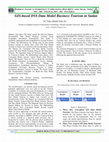
Sudanese Journal of Computing and Geoinformatics(SJCG)- ISSN: 1858-8336 (Online),ISSN: 1858-8328 (Print) , ALZAIEM ALAZHARI UNIVERSITY, 2017
Abstract– This paper This Study explain the Decision Support System(DSS) Data Model Business Tour... more Abstract– This paper This Study explain the Decision Support System(DSS) Data Model Business Tourism Using Geographic Information System(GIS), This model is explained, implemented and exemplified for Tourism Products in Sudan. The Motivations are: Strong need for data model business tourism in Sudan ,there aren't GIS Data Model Tourism in Sudan, lack research in the Geoinformatics fields. The Objects are Conceptual GIS Data Model Tourism, Logical GIS Data Model Tourism, Physical GIS Data Model Tourism. The Important Study for Decision Support Makers for Tourism in Sudan. The Methodology three phases: First: Conceptual Model, Second: Logical Model, third: Physical Model. The Results: There are 5A's to Build the Conceptual GIS Model (Attraction, Accommodation, Access, Amenity, Awareness), The Recommendations: Design & Implementation Geodatabase Business Tourism in Sudan, Geodatabase Developer Business Tourism in Sudan, Georelation Business Tourism in Sudan. The Future Study: The Geoinformatics Potentials for Build the Data Model Business Tourism in Sudan.
Keywords : GIS, Remote Sensing, Geoinformatics, Geodatabase, Object-relational database..
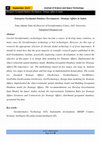
CRETEAN: Regional Center for Remote Sensing of North Africa States, Journal of science & Space Technology, Pages: 56-64, Tunis, No (5), Nov 2019. ISSN: 2490-4244, 2019
Current Geoinformatics technologies have become a source of develop many countries, in many cases... more Current Geoinformatics technologies have become a source of develop many countries, in many cases the Geoinformatics technology is best technologies. However, for this type of research the appropriate selection of relevant model technology is of great importance. It should be noted here that the great majority of scientific research papers published in this field Geodatabase institute, practically neglecting country development, in that context the objective of this paper is to design data modeling for Strategic Affairs, Implemented the object-relational spatial database model, Building Geospatial Database model for Strategic Affairs.The importance are The methodology based on five stages, one stage in analysis phase, two stages in design phase and last stage in implementation design phase. The results are classified Strategic Affairs (GeoScience, GeoIntelligence, GeoMilitary, GeoPolitic,GeoEconomic,GeoSociety, GeoTechnology), Design data modeling for Strategic Affairs, Implemented the object-relational spatial database model and Building Geospatial Database model for Strategic Affairs. The recommendations are Develop Georelational Data Model; the future studies include the representation Validation Rules for Strategic Affairs Geometry and Connectivity for Strategic Affairs, distributed geospatial database, geospatial big data.
Key words:
Geoinformatics Technology (GT), Sustainable development, SMART Country, Strategic intelligent (SI),and economic intelligent (EI).
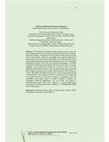
1st Science Engineering Technology and Sustainability International Conference (SETS2021), 2021
Abstract: The demand for renewable energy resources, such as solar, has
been greatly stepped up ... more Abstract: The demand for renewable energy resources, such as solar, has
been greatly stepped up to meet the growing global demand for sustainablyproduced electricity, compared to non-renewable resources such as coal, gas
and oil (fossil fuels), which are responsible for the global emissions of
approximately 65% of greenhouse gas (GHG). One of the efficient tool for
demonstrating information along with geographical data is the Geographic
Information Systems (GIS) where the generated knowledge is severally
important for efficient decision-making. The energy from solar is becoming
gradually a great solution for energy for our planet, where it is nonpolluting, and an infinite and free source. Modeling solar energy using GIS
data is helping to generate more design elements from the GIS existing sets
of data. The model will include several layers, such as logical, physical and
conceptual layers. This study key objective is to propose a new method that
was designed based on GIS data to produce a conceptual model for
sustainable solar energy based on Object Modeling Technique for
Geographic (OMT-G) applications. The new model can produce a
logical/physical model which can be applied to a virtual programming
environment to build geoprocessing workflows, i.e., ModelBuilder (ESRI
ArcGIS technology).
Keywords: Renewable Energy (RE), Geospatial Data Science (GDS),
Sustainable Developments Goals (SDG's).
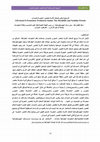
GIS &Geospace Applications Journal , Tunis, 2017
تتناول الدراسة ترويج للمعالم الاثرية بالعصر الحجري بالسودان باستخدام نظم المعلومات الجغرافية ، ال... more تتناول الدراسة ترويج للمعالم الاثرية بالعصر الحجري بالسودان باستخدام نظم المعلومات الجغرافية ، الدوافع من الدراسة تمثلت في قلة الدراسات والبحوث التي تربط بين مجالات نظم المعلومات الجغرافية ومجال الجيومعلوماتية ومجال الأثار، إضافة الي قلة المعلومات الوصفية والمكانية للمعالم الأثرية للعصور الحجرية، عدم وجود تطبيقات تكنولوجية تقوم بتوثيق المعالم الأثرية للعصور الحجرية، تمثلت أهداف الدراسة في جمع وتصنيف المعلومات المكانية والوصفية للمعالم الأثرية للعصور الحجرية بمنطقة الخرطوم، تصميم خريطة أساس للمعالم الاثرية للعصور الحجرية بمنطقة الخرطوم، وتصميم موقع إلكتروني لتوثيق المعالم الاثرية للعصور الحجرية بمنطقة الخرطوم. تمثلت أهمية الدراسة للمساهمة في دعم إتخاذ القرار في توضيح إمكانية نظم المعلومات الجغرافية في التوثيق الالكتروني للمعالم الاثرية للعصور الحجرية بمنطقة الخرطوم، تأسيس قاعدة معلومات موحدة للاثار السودانية لدعم الباحثين ومتخذي القرار، المساهمة في دعم الاثار السودانية. تم اتباع منهجية التحليل الوصفي التطبيقي. ومن أهم النتائج التي تم الوصول اليهاان منطقة الخرطوم تحتوي علي 18 موقع أثري بالعصر الحجري. 8 موقع أثري بمدينة الخرطوم، 3 مواقع أثرية بمدينة بحري، 7 مواقع أثرية مدينة أم درمان.وجود 5 مواقع أثرية مشتركة بالعصر الحجري والمروي(معا)، 1 بمدينة الخرطوم، و1 بمدينة بحري و 3 بمدينة ام درمان.وجود 2 موقع أثري مشترك بالعصر الحجري والمسيحي(معا) و 2 بمدينة ام درمان. بالاضافة الي إنتاج العديد من خرائط للمواقع الأثرية بالعصر الحجري و العصور المشتركة بالعصر الحجري والمروي(معا)، و العصر المشتركة بالعصر الحجري والمسيحي(معا).أيضا تم بناء خريطة أساس للمغالم الاثرية للعصور الحجرية، إضافة الي تصميم تطبيق ويب للتوثيق لدعم متخذي القرار بالمعلومات الوصفية والمكانية. تم استخراج مجموعة من التوصيات من أهمها : بناء قاعدة البيانات الجغرافية للمعالم الاثرية بالعصور الحجرية في السودان، تطوير التطبيق الالكتروني لتوثيق المعالم الاثرية بالعصور الحجرية علي مستوي السودان، تحليل الصورة الجوية لمعالم العصور الحجرية باستخدام الاستشعار عن بعد. كما أوصت الدراسة بالعديد من الدراسات المستقبلية المتمثلة في توضيح امكانيات الجيومعلوماتية للمعالم الاثرية بالعصور الحجرية، تصميم تطبيق انمي يوضح معالم العصور الحجرية في السودان، بناء نموذج ثلاثي الابعاد للعصور الحجرية في السودان.
الكلمات المفتاحية: نظم المعلومات الجغرافية (GIS) ، الاستشعار عن بعد (Remote Sensing)، الجيومعلوماتية (Geoinformatics)، السياحة(Tourism)، قواعد البيانات الجغرافية (Geodatabase)، التوثيق المكاني( Spatial Archive).
The third International Conference on Mahdism Scientific Studies, University Of El Imam El Mahdi, 2018
Papers by Taha A L F A D U L Taha Ali
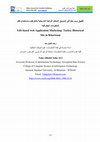
Rihan Journal for Scientific Publishing(ISSN:2709-2097), The Ministry of Education & High Education, Syrian., Sep 28, 2022
This paper illustrates the GIS-based Applications web marketing: Turkey Historical Site in Kharto... more This paper illustrates the GIS-based Applications web marketing: Turkey Historical Site in Khartoum, The Motivation depend on Role Geoinformatics Technology for Evaluate the historical sites. The objectives are Analysis, Design, and Implementation Turkey Historical Site in Khartoum. The Importance to support the decision Makers/ Supports. The Methodology is Geoinformatics Phases (Analysis, Design, and Implementations).
The importance Results: Design Turkey GeoHistorical Data Model, Build Turkey GeoHistorical Geodatabase, implementation Turkey GeoHistorical Applications Map, Develop Turkey GeoHistorical thematic Map. We recommendations: Design Turkey GeoHistorical virtual Reality, Implementation Turkey GeoHistorical Map in Sudan, Implementation Turkey GeoHistorical Application in Sudan. The Future Papers: Implementation Turkey GeoHistorical 3D Model in Sudan.
Keywords: Geographic Information System-GIS, Remote Sensing, Historical Geodatabase- HGDB, Geospatial/Geoinformatics Technology.
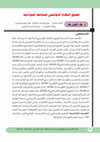
Algulzum Scientific Documentary Journal(ISSN: 1858-9790) , 2022
تطبيق النظام المؤسسي للمتاحف السودانية
Sudanese Enterprise Museum System - SEMS
د. طه الفضل طه، ا... more تطبيق النظام المؤسسي للمتاحف السودانية
Sudanese Enterprise Museum System - SEMS
د. طه الفضل طه، استاذ مشارك في تقانة المعلومات(علوم البيانات المكانية)، جامعة الزعيم الازهري
Tahapilot13@gmail.com
المستخلص
ناقشت هذه الدراسة تطبيق النظام المؤسسي للمتاحف السودانية، كما تمثلت مشكلة الدراسة في عدم وجود دراسة متكاملة لتطبيق شامل لادارة المتاحف السودانية، لتعزيز التنمية المستدامة في القطاعات الاجتماعية والاقتصادية والبيئية في السودان. كما يتمثل الهدف الرئيس للدراسة في تحليل وتصميم وتطبيق النظام المؤسسي للمتاحف السودانية في خمسة تطبيقات اساسية (ادارة التطبيق التقنيSEMS-T ، ادارة تطبيق الوظائف الادارية SEMS-F ، ادارة تطبيق المقتنيات SEMS-A ، ادارة تطبيق التحليلات الاحصائية SEMS-S ، ادارة تطبيق الواقع الافتراضي SEMS-R)، كما تتمثل أهمية الدراسة في دعم متخذي القرار، والمهتمين، والباحثين، والسياح، ومطور النظم ، ومطوري ادارة المشروعات بالبيانات والمعلومات والاحصائيات والمهام التي تطور مؤسسات المتاحف السودانية.
ولقد توصلت الدراسة الي العديد من النتائج من اهمها : تحليل وتصميم وتطبيق النظام المؤسسي للمتاحف السودانية في خمسة تطبيقات اساسية (ادارة التطبيق التقنيSEMS-T ، ادارة تطبيق الوظائف الادارية SEMS-F ، ادارة تطبيق المقتنيات SEMS-A ، ادارة تطبيق التحليلات الاحصائية SEMS-S ، ادارة تطبيق الواقع الافتراضي SEMS-R). كما ولقد توصلت الدراسة الي اهم التوصيات من أهمها : تطبيق النظام المؤسسي للمتاحف السودانية، في كل متاحف السودان، مع ربط قاعدة البيانات بالتخزين السحابي، وربط اجهزت الحساسات لزوار المتاحف، وانشاء فريق الطائرات بدون طيار لدعم تسويق وترويج المتاحف السودانية. كما توصلت الدراسة الي اهم الدراسات المستقبلية في تحليل وتصميم وتنفيذ كل تطبيق علي حده من التطبيقات الخمسة اعلاه.
مفتاح الكلمات : التحليل الاحصائي (SPSS)، ادارة المشروعات (PMP)، الواقع المعزز للمتاحف (Augmented Reality Museum (ARM))، الجولة 360 درجة (360-degree Virtual Tour)، نظم المعلومات الجغرافية (GIS)
Sudanese Enterprise Museum System – SEMS
Dr. Taha Alfadul Taha Ali,
Associate Professor of Information Technology (Geospatial Data Science), Alzaiem Alazhari University,Tahapilot13@gmail.com
This Study illustrate the Sudanese Enterprise Museum System – SEMS, the problem of the study was the absence of an integrated study for a comprehensive application of the management of Sudanese museums, to promote sustainable development in the social, economic and environmental sectors in Sudan. The main objective of the study is to analyze, design and apply the Sudanese Enterprise Museum System – SEMS in five basic applications (technical application management SEMS-T, management of the application of administrative functions SEMS-F, management of the application of holdings SEMS-A, statistical analysis application management SEMS-S, reality application management SEMS-R), and the importance of the study is to support decision-makers, stakeholders, researchers, tourists, systems developers, and project management developers with data, information, statistics and tasks that develop Sudanese museum institutions.
The study reached many results, the most important of which are: analysis, design and application of the Sudanese Enterprise Museum System – SEMS in five basic applications (Technical Application Management SEMS-T, SEMS-F Administrative Functions Application Management, SEMS-A Holdings Application Management, SEMS-S Statistical Analysis Application Management SEMS-R Virtual Reality Application Management. The study also reached the most important recommendations, the most important of which are: the application of the institutional system for Sudanese museums, in all the museums of Sudan, with linking the database to cloud storage, linking sensor devices to museum visitors, and establishing a drone team to support the marketing and promotion of Sudanese museums. The study also found the most important future studies in the analysis, design and implementation of each of the above five applications separately.
Keyword: SPSS, Project Management, Augmented Reality Museum (ARM), 360-degree Virtual Tour.
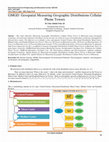
International Journal of Engineering and Information Systems (IJEAIS), 2022
This study illustrates Measuring Geographic Distributions Cellular Phone Towers in Khartoum using... more This study illustrates Measuring Geographic Distributions Cellular Phone Towers in Khartoum using Geospatial technology, the motivations depend on GeoSmart city has become one of the hot issues of Geoinformatics technology and applied in Africa& Asia country. The objectives as to identify, create, and measure Central Feature, Directional Distribution, Mean Center, Median Center and Standard Distance for Towers.
There are 226 Towers in Khartoum Locality: 90 Towers(in Khartoum East), 19 Towers(in Khartoum west), 19 Towers(in Khartoum Central), 78 Towers(in Khartoum Soba), 10 Towers(in Khartoum Al-shagrah). Hug Towers impacts for our life’s. in addition to measure Geographic Distributions Cellular Phone Towers in Khartoum
There are many future researches: GEMS(Global Environment Monitoring System), Geoinformatics GeoSmart City: Pollutions for Cellular Phone Towers, GEMS-Geoinformatics GeoSmart City: The Environment pollution and Electromagnetic radiation pollution, Geospatial Technology: Spatial Statistic for Measuring Geographic Distributions Cellular Phone Towers in Khartoum, GEMS-Geoinformatics GeoSmart City: Spatial Statistic for Measuring Geographic Distributions Cellular Phone Towers in Khartoum.
Keywords
GIS, Remote Sensing, GEMS; Electromagnetic Environmental Pollutions; Electromagnetic radiation, electromagnetic environment; electromagnetic compatibility.
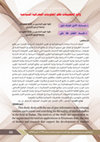
Algulzum Scientific Journal, No:17, 2022
واقع التطبيقات الجيومعلوماتية للسياحة في السودان.
د. طه الفضل طه علي
tahapilot13@gmail.com
كل... more واقع التطبيقات الجيومعلوماتية للسياحة في السودان.
د. طه الفضل طه علي
tahapilot13@gmail.com
كلية علوم الحاسوب وتقانة المعلومات، جامعة الزعيم الازهري
المستخلص: تتناول الدراسة استخدام الجيومعلوماتية في تطوير التطبيقات السياحية والبحث عن واقع الدراسات التطبيقية في المجال علي مستوي السودان، إن الدوافع من الورقة الحوجة الماسة الي تطبيقات سياحية بولاية الخرطوم، قلة الدراسات والبحوث التي تدعم تطوير التطبيقات السياحية بولاية الخرطوم، إبراز امكانيات الجيومعلوماتية لتطوير التطبيقات السياحية. إن أهداف الدراسة تطوير التطبيقات المكانية السياحية بولاية الخرطوم عبر تطبيق شخصي ، تطوير التطبيقات المكانية السياحية بولاية الخرطوم عبر الويب، تطوير التطبيقات المكانية السياحية بولاية الخرطوم عبر الموبايل، تطوير التطبيقات السياحية بولاية الخرطوم عبر مواقع التواصل الاجتماعية، تطوير التطبيقات السياحية بولاية الخرطوم عبر تطبيقات الواقع الافتراضي، تطوير التطبيقات السياحية بولاية الخرطوم عبر مواقع الثقافة الالكترونية، تطوير التطبيقات الاحصائية السياحية بولاية الخرطوم. إن أهمية الدراسة تتمثل في تطوير التطبيقات السياحية بولاية الخرطوم بغرض دعم متخذي القرار والسياح أو الزوار والباحثين والطلاب والمثقفين وذوي الاهتمام. إن منهجية الدراسة تتمثل في دورة حياة تطوير النظم. إن نتائج الدراسة تتمثل في إمكانيات تطوير التطبيفات السياحية لولاية الخرطوم باستخدام الجيومعلوماتية من خلال بناء مجموعة من التطبيقات عبر تطبيق شخصي وعبر الويب وعبر الموبايل وعبر مواقع التواصل الاجتماعية، و عبر تطبيقات الواقع الافتراضي، وعبر مواقع الثقافة الالكترونية، وعبر التطبيقات الاحصائية السياحية بولاية الخرطوم. توصي الدراسة بتصميم تطبيق يشمل كل التطبيقات السابقة في تطبيق واحد مع إمكانيات محددات الوصول للمستخدمين حسب الغرض. كما توصي الدراسة بالعديد من الدراسات المستقبلية والتي تتمثل في الاستفادة من التطبيقات في تحليل الواقع السياحي بالسودان، تقييم الواقع السياحي بالسودان، تطوير الواقع السياحي بالسودان.
مفتاح الكلمات : المتاحف (Museums)، الآثار(Archeology)، الفنادق(Hotels)، نظم المعلومات الجغرافية(GIS)، الاستشعار عن بعد(Remote Sensing).
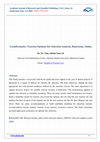
Academic Journal of Research and Scientific Publishing (AJRSP), Volume 2(14), 5 July-2020, pages (41-53).ISSN: 2706-6495, www.ajrsp.com, 2020
This Study presents a successful solution for spatial decision support in the case of spatial ana... more This Study presents a successful solution for spatial decision support in the case of spatial analysis of Khartoum as a region of interest for tourism site selection. The main objectives: finding the most appropriate site with desired conditions defined by the selection criteria. The main importance's is support decision makers for suitable tourism location in Khartoum. The methodology applied in optimal site selection or suitability modeling. There are many results: build Geodatabase for tourism, build a suitability model for tourism, discovered the optimal sites for land the new tourism site and displays the three location of the optimal site for the new tourism site like Hi shati, Mogran and sunt forest. There are many recommendations as build suitability modeling for attraction tourism, accommodation tourism, amenity tourism, access tourism, awareness tourism. The future researches are build application systematic for Optimal Site Selection.
Geospatial Sudan Forum, GSF Group & Geoinformatics Center, Alzaeim Alazhari University, Khartoum, Sudan, GSF2018, 8/5/2018, 2018
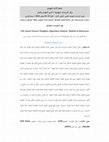
المستخلص: تتناول الورقة استخدام خوارزمية صلة جوار لتحليل المعالم الجغرافية التاريخية لدولة المهدي... more المستخلص: تتناول الورقة استخدام خوارزمية صلة جوار لتحليل المعالم الجغرافية التاريخية لدولة المهدية بمدن ولاية الخرطوم باستخدام نظم المعلومات الجغرافية، حيث تمثلت مشكلة الورقة في قلة الدراسات التي تربط بين مجالات تقانة المعلومات والتاريخ السوداني، وقلة المعلومات الخاصة بالمعالم الجغرافية التاريخية لدولة المهدية بولاية الخرطوم، وعدم وجود تحليل جغرافي للمواقع الجغرافية التاريخية بدولة المهدية. كما تتمثل أهمية الورقة في توضيح أهمية نظم المعلومات الجغرافية ودورها في التحليل الجغرافي وتقييم للمعالم التاريخية لدولة المهدية. كما تتمثل أهداف الورقة في جمع وتصنيف المعالم الجغرافية التاريخية لدولة المهدية بولاية الخرطوم، بناء نموذج تحليل صلة الجوار الجغرافي للمعالم الجغرافية التاريخية لدولة المهدية بولاية الخرطوم، تقييم نمط التوزيع الجغرافي للمعالم الجغرافية التاريخية لدولة المهدية بولاية الخرطوم. سوف يتم استخدام المنهجية التحليلية الوصفية المتمثلة في التحليل والتصميم والتطبيق. توصلت الورقة الي العديد من النتائج من أهمها: بناء نموذج تحليل صلة الجوار للبيانات الجغرافية للمعالم الجغرافية التاريخية لدولة المهدية بولاية الخرطوم، تقييم نمط التوزيع الجغرافي للمعالم الجغرافية التاريخية لدولة المهدية بولاية الخرطوم. كما توصي الورقة الي العديد من التوصيات من أهمها: جمع وتصنيف المعالم الجغرافية التاريخية لدولة المهدية بالسودان، بناء نموذج التحليل المكاني للبيانات الجغرافية للمعالم الجغرافية التاريخية لدولة المهدية بالسودان، تقييم واقع التوزيع الجغرافي للمعالم الجغرافية التاريخية لدولة المهدية بالسودان. ومن أهم التوصيات المستقبلية للورقة تحليل انماط التوزيع الجغرافي لجميع المعالم الجغرافية التاريخية لدولة المهدية بالسودان.
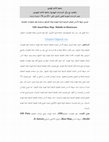
The Second International Conference on Mahdism Scientific Studies, University Of El Imam El Mahdi, 2017
تتناول الورقة تصميم خريطة الأساس للمعالم الجغرافية التاريخية لدولة المهدية باستخدام نظم المعلومات... more تتناول الورقة تصميم خريطة الأساس للمعالم الجغرافية التاريخية لدولة المهدية باستخدام نظم المعلومات الجغرافية بولاية الخرطوم، حيث تمثلت مشكلة الورقة في قلة الدراسات التي تربط بين مجالات تقانة المعلومات والتاريخ السوداني، وقلة المعلومات الخاصة بالمعالم الجغرافية التاريخية لدولة المهدية بولاية الخرطوم، وعدم وجود خريطة أساس للمعالم الجغرافية التاريخية بدولة المهدية. كما تتمثل أهمية وأهداف الورقة في توضيح أهمية نظم المعلومات الجغرافية ودورها في توثيق وادارة المعالم التاريخية لدولة المهدية، جمع وتصنيف المعالم الجغرافية التاريخية لدولة المهدية بولاية الخرطوم، نشاء خريطة الاساس للمعالم الجغرافية التاريخية لدولة المهدية بولاية الخرطوم. سوف يتم استخدام المنهجية التحليلية الوصفية المتمثلة في التحليل والتصميم والتطبيق. توصلت الورقة الي العديد من النتائج من أهمها: جمع وتصنيف 13 معلم تاريخي لدولة المهدية بولاية الخرطوم ( واحد معلم بمدينة الخرطوم، واحد معلم بمدينة بحري، احدي عشر معلم بمدينة ام درمان)، انشاء خريطة الاساس للمعالم الجغرافية التاريخية لدولة المهدية بولاية الخرطوم. كما توصي الورقة الي العديد من التوصيات من أهمها: جمع وتصنيف المعالم الجغرافية التاريخية لدولة المهدية بالسودان، تصميم نموذج البيانات الجغرافي للمعالم الجغرافية التاريخية لدولة المهدية بالسودان، انشاء خريطة الاساس للمعالم الجغرافية التاريخية لدولة المهدية بالسودان. ومن أهم التوصيات المستقبلية للورقة التوثيق الالكتروني للميديا لجميع المعالم الجغرافية التاريخية لدولة المهدية بالسودان.











Uploads
Thesis Chapters-ANN by Taha A L F A D U L Taha Ali
This paper analyzes the shortcomings of previous approaches in renewable energy using GIS Modeling, Multi Criteria Model, and Sustainable Model. Geospatial has become decision Support Maker, and how to enable sustainable energy efforts. Multi-criteria modeling in Geospatial has proven useful for locating optimal areas.
We are currently essential trends: GIS Modeling, Multi Criteria Model, and Sustainable Model. And future research Geospatial renewable energy research: Decentralization Data Storage, Sensor data via internet of things(IoT), Big Data, BlockChain, 3D Building Models, CyberSecurity, Geospatial 3D Analysis, and Geovisualization.
Keywords: GIS; Sustainable and Smart city; Geospatial Analysis.
الكلمات المفتاحية : نظم المعلومات الجغرافيةالأثرية (Archeology Geographic Information System-AGIS)، قاعدة البيانات الجغرافية الأثرية (Archeology Geodatabase-AGDB)، تطبيقات الجيومعلوماتية Geoinformatics Application
مفتاح الكلمات: نظم المعلومات الجغرافية(GIS)، الدولة المهدية، نموذج البيانات الجغرافي(GIS Data Model)، تحليل صلة الجوار(ANN).
Keywords—Geoinformatics, DDS(Dicision Support System), Geostatistical Analysis, Base Maps.
Keywords : GIS, Remote Sensing, Geoinformatics, Geodatabase, Object-relational database..
Key words:
Geoinformatics Technology (GT), Sustainable development, SMART Country, Strategic intelligent (SI),and economic intelligent (EI).
been greatly stepped up to meet the growing global demand for sustainablyproduced electricity, compared to non-renewable resources such as coal, gas
and oil (fossil fuels), which are responsible for the global emissions of
approximately 65% of greenhouse gas (GHG). One of the efficient tool for
demonstrating information along with geographical data is the Geographic
Information Systems (GIS) where the generated knowledge is severally
important for efficient decision-making. The energy from solar is becoming
gradually a great solution for energy for our planet, where it is nonpolluting, and an infinite and free source. Modeling solar energy using GIS
data is helping to generate more design elements from the GIS existing sets
of data. The model will include several layers, such as logical, physical and
conceptual layers. This study key objective is to propose a new method that
was designed based on GIS data to produce a conceptual model for
sustainable solar energy based on Object Modeling Technique for
Geographic (OMT-G) applications. The new model can produce a
logical/physical model which can be applied to a virtual programming
environment to build geoprocessing workflows, i.e., ModelBuilder (ESRI
ArcGIS technology).
Keywords: Renewable Energy (RE), Geospatial Data Science (GDS),
Sustainable Developments Goals (SDG's).
الكلمات المفتاحية: نظم المعلومات الجغرافية (GIS) ، الاستشعار عن بعد (Remote Sensing)، الجيومعلوماتية (Geoinformatics)، السياحة(Tourism)، قواعد البيانات الجغرافية (Geodatabase)، التوثيق المكاني( Spatial Archive).
Papers by Taha A L F A D U L Taha Ali
The importance Results: Design Turkey GeoHistorical Data Model, Build Turkey GeoHistorical Geodatabase, implementation Turkey GeoHistorical Applications Map, Develop Turkey GeoHistorical thematic Map. We recommendations: Design Turkey GeoHistorical virtual Reality, Implementation Turkey GeoHistorical Map in Sudan, Implementation Turkey GeoHistorical Application in Sudan. The Future Papers: Implementation Turkey GeoHistorical 3D Model in Sudan.
Keywords: Geographic Information System-GIS, Remote Sensing, Historical Geodatabase- HGDB, Geospatial/Geoinformatics Technology.
Sudanese Enterprise Museum System - SEMS
د. طه الفضل طه، استاذ مشارك في تقانة المعلومات(علوم البيانات المكانية)، جامعة الزعيم الازهري
Tahapilot13@gmail.com
المستخلص
ناقشت هذه الدراسة تطبيق النظام المؤسسي للمتاحف السودانية، كما تمثلت مشكلة الدراسة في عدم وجود دراسة متكاملة لتطبيق شامل لادارة المتاحف السودانية، لتعزيز التنمية المستدامة في القطاعات الاجتماعية والاقتصادية والبيئية في السودان. كما يتمثل الهدف الرئيس للدراسة في تحليل وتصميم وتطبيق النظام المؤسسي للمتاحف السودانية في خمسة تطبيقات اساسية (ادارة التطبيق التقنيSEMS-T ، ادارة تطبيق الوظائف الادارية SEMS-F ، ادارة تطبيق المقتنيات SEMS-A ، ادارة تطبيق التحليلات الاحصائية SEMS-S ، ادارة تطبيق الواقع الافتراضي SEMS-R)، كما تتمثل أهمية الدراسة في دعم متخذي القرار، والمهتمين، والباحثين، والسياح، ومطور النظم ، ومطوري ادارة المشروعات بالبيانات والمعلومات والاحصائيات والمهام التي تطور مؤسسات المتاحف السودانية.
ولقد توصلت الدراسة الي العديد من النتائج من اهمها : تحليل وتصميم وتطبيق النظام المؤسسي للمتاحف السودانية في خمسة تطبيقات اساسية (ادارة التطبيق التقنيSEMS-T ، ادارة تطبيق الوظائف الادارية SEMS-F ، ادارة تطبيق المقتنيات SEMS-A ، ادارة تطبيق التحليلات الاحصائية SEMS-S ، ادارة تطبيق الواقع الافتراضي SEMS-R). كما ولقد توصلت الدراسة الي اهم التوصيات من أهمها : تطبيق النظام المؤسسي للمتاحف السودانية، في كل متاحف السودان، مع ربط قاعدة البيانات بالتخزين السحابي، وربط اجهزت الحساسات لزوار المتاحف، وانشاء فريق الطائرات بدون طيار لدعم تسويق وترويج المتاحف السودانية. كما توصلت الدراسة الي اهم الدراسات المستقبلية في تحليل وتصميم وتنفيذ كل تطبيق علي حده من التطبيقات الخمسة اعلاه.
مفتاح الكلمات : التحليل الاحصائي (SPSS)، ادارة المشروعات (PMP)، الواقع المعزز للمتاحف (Augmented Reality Museum (ARM))، الجولة 360 درجة (360-degree Virtual Tour)، نظم المعلومات الجغرافية (GIS)
Sudanese Enterprise Museum System – SEMS
Dr. Taha Alfadul Taha Ali,
Associate Professor of Information Technology (Geospatial Data Science), Alzaiem Alazhari University,Tahapilot13@gmail.com
This Study illustrate the Sudanese Enterprise Museum System – SEMS, the problem of the study was the absence of an integrated study for a comprehensive application of the management of Sudanese museums, to promote sustainable development in the social, economic and environmental sectors in Sudan. The main objective of the study is to analyze, design and apply the Sudanese Enterprise Museum System – SEMS in five basic applications (technical application management SEMS-T, management of the application of administrative functions SEMS-F, management of the application of holdings SEMS-A, statistical analysis application management SEMS-S, reality application management SEMS-R), and the importance of the study is to support decision-makers, stakeholders, researchers, tourists, systems developers, and project management developers with data, information, statistics and tasks that develop Sudanese museum institutions.
The study reached many results, the most important of which are: analysis, design and application of the Sudanese Enterprise Museum System – SEMS in five basic applications (Technical Application Management SEMS-T, SEMS-F Administrative Functions Application Management, SEMS-A Holdings Application Management, SEMS-S Statistical Analysis Application Management SEMS-R Virtual Reality Application Management. The study also reached the most important recommendations, the most important of which are: the application of the institutional system for Sudanese museums, in all the museums of Sudan, with linking the database to cloud storage, linking sensor devices to museum visitors, and establishing a drone team to support the marketing and promotion of Sudanese museums. The study also found the most important future studies in the analysis, design and implementation of each of the above five applications separately.
Keyword: SPSS, Project Management, Augmented Reality Museum (ARM), 360-degree Virtual Tour.
There are 226 Towers in Khartoum Locality: 90 Towers(in Khartoum East), 19 Towers(in Khartoum west), 19 Towers(in Khartoum Central), 78 Towers(in Khartoum Soba), 10 Towers(in Khartoum Al-shagrah). Hug Towers impacts for our life’s. in addition to measure Geographic Distributions Cellular Phone Towers in Khartoum
There are many future researches: GEMS(Global Environment Monitoring System), Geoinformatics GeoSmart City: Pollutions for Cellular Phone Towers, GEMS-Geoinformatics GeoSmart City: The Environment pollution and Electromagnetic radiation pollution, Geospatial Technology: Spatial Statistic for Measuring Geographic Distributions Cellular Phone Towers in Khartoum, GEMS-Geoinformatics GeoSmart City: Spatial Statistic for Measuring Geographic Distributions Cellular Phone Towers in Khartoum.
Keywords
GIS, Remote Sensing, GEMS; Electromagnetic Environmental Pollutions; Electromagnetic radiation, electromagnetic environment; electromagnetic compatibility.
د. طه الفضل طه علي
tahapilot13@gmail.com
كلية علوم الحاسوب وتقانة المعلومات، جامعة الزعيم الازهري
المستخلص: تتناول الدراسة استخدام الجيومعلوماتية في تطوير التطبيقات السياحية والبحث عن واقع الدراسات التطبيقية في المجال علي مستوي السودان، إن الدوافع من الورقة الحوجة الماسة الي تطبيقات سياحية بولاية الخرطوم، قلة الدراسات والبحوث التي تدعم تطوير التطبيقات السياحية بولاية الخرطوم، إبراز امكانيات الجيومعلوماتية لتطوير التطبيقات السياحية. إن أهداف الدراسة تطوير التطبيقات المكانية السياحية بولاية الخرطوم عبر تطبيق شخصي ، تطوير التطبيقات المكانية السياحية بولاية الخرطوم عبر الويب، تطوير التطبيقات المكانية السياحية بولاية الخرطوم عبر الموبايل، تطوير التطبيقات السياحية بولاية الخرطوم عبر مواقع التواصل الاجتماعية، تطوير التطبيقات السياحية بولاية الخرطوم عبر تطبيقات الواقع الافتراضي، تطوير التطبيقات السياحية بولاية الخرطوم عبر مواقع الثقافة الالكترونية، تطوير التطبيقات الاحصائية السياحية بولاية الخرطوم. إن أهمية الدراسة تتمثل في تطوير التطبيقات السياحية بولاية الخرطوم بغرض دعم متخذي القرار والسياح أو الزوار والباحثين والطلاب والمثقفين وذوي الاهتمام. إن منهجية الدراسة تتمثل في دورة حياة تطوير النظم. إن نتائج الدراسة تتمثل في إمكانيات تطوير التطبيفات السياحية لولاية الخرطوم باستخدام الجيومعلوماتية من خلال بناء مجموعة من التطبيقات عبر تطبيق شخصي وعبر الويب وعبر الموبايل وعبر مواقع التواصل الاجتماعية، و عبر تطبيقات الواقع الافتراضي، وعبر مواقع الثقافة الالكترونية، وعبر التطبيقات الاحصائية السياحية بولاية الخرطوم. توصي الدراسة بتصميم تطبيق يشمل كل التطبيقات السابقة في تطبيق واحد مع إمكانيات محددات الوصول للمستخدمين حسب الغرض. كما توصي الدراسة بالعديد من الدراسات المستقبلية والتي تتمثل في الاستفادة من التطبيقات في تحليل الواقع السياحي بالسودان، تقييم الواقع السياحي بالسودان، تطوير الواقع السياحي بالسودان.
مفتاح الكلمات : المتاحف (Museums)، الآثار(Archeology)، الفنادق(Hotels)، نظم المعلومات الجغرافية(GIS)، الاستشعار عن بعد(Remote Sensing).
This paper analyzes the shortcomings of previous approaches in renewable energy using GIS Modeling, Multi Criteria Model, and Sustainable Model. Geospatial has become decision Support Maker, and how to enable sustainable energy efforts. Multi-criteria modeling in Geospatial has proven useful for locating optimal areas.
We are currently essential trends: GIS Modeling, Multi Criteria Model, and Sustainable Model. And future research Geospatial renewable energy research: Decentralization Data Storage, Sensor data via internet of things(IoT), Big Data, BlockChain, 3D Building Models, CyberSecurity, Geospatial 3D Analysis, and Geovisualization.
Keywords: GIS; Sustainable and Smart city; Geospatial Analysis.
الكلمات المفتاحية : نظم المعلومات الجغرافيةالأثرية (Archeology Geographic Information System-AGIS)، قاعدة البيانات الجغرافية الأثرية (Archeology Geodatabase-AGDB)، تطبيقات الجيومعلوماتية Geoinformatics Application
مفتاح الكلمات: نظم المعلومات الجغرافية(GIS)، الدولة المهدية، نموذج البيانات الجغرافي(GIS Data Model)، تحليل صلة الجوار(ANN).
Keywords—Geoinformatics, DDS(Dicision Support System), Geostatistical Analysis, Base Maps.
Keywords : GIS, Remote Sensing, Geoinformatics, Geodatabase, Object-relational database..
Key words:
Geoinformatics Technology (GT), Sustainable development, SMART Country, Strategic intelligent (SI),and economic intelligent (EI).
been greatly stepped up to meet the growing global demand for sustainablyproduced electricity, compared to non-renewable resources such as coal, gas
and oil (fossil fuels), which are responsible for the global emissions of
approximately 65% of greenhouse gas (GHG). One of the efficient tool for
demonstrating information along with geographical data is the Geographic
Information Systems (GIS) where the generated knowledge is severally
important for efficient decision-making. The energy from solar is becoming
gradually a great solution for energy for our planet, where it is nonpolluting, and an infinite and free source. Modeling solar energy using GIS
data is helping to generate more design elements from the GIS existing sets
of data. The model will include several layers, such as logical, physical and
conceptual layers. This study key objective is to propose a new method that
was designed based on GIS data to produce a conceptual model for
sustainable solar energy based on Object Modeling Technique for
Geographic (OMT-G) applications. The new model can produce a
logical/physical model which can be applied to a virtual programming
environment to build geoprocessing workflows, i.e., ModelBuilder (ESRI
ArcGIS technology).
Keywords: Renewable Energy (RE), Geospatial Data Science (GDS),
Sustainable Developments Goals (SDG's).
الكلمات المفتاحية: نظم المعلومات الجغرافية (GIS) ، الاستشعار عن بعد (Remote Sensing)، الجيومعلوماتية (Geoinformatics)، السياحة(Tourism)، قواعد البيانات الجغرافية (Geodatabase)، التوثيق المكاني( Spatial Archive).
The importance Results: Design Turkey GeoHistorical Data Model, Build Turkey GeoHistorical Geodatabase, implementation Turkey GeoHistorical Applications Map, Develop Turkey GeoHistorical thematic Map. We recommendations: Design Turkey GeoHistorical virtual Reality, Implementation Turkey GeoHistorical Map in Sudan, Implementation Turkey GeoHistorical Application in Sudan. The Future Papers: Implementation Turkey GeoHistorical 3D Model in Sudan.
Keywords: Geographic Information System-GIS, Remote Sensing, Historical Geodatabase- HGDB, Geospatial/Geoinformatics Technology.
Sudanese Enterprise Museum System - SEMS
د. طه الفضل طه، استاذ مشارك في تقانة المعلومات(علوم البيانات المكانية)، جامعة الزعيم الازهري
Tahapilot13@gmail.com
المستخلص
ناقشت هذه الدراسة تطبيق النظام المؤسسي للمتاحف السودانية، كما تمثلت مشكلة الدراسة في عدم وجود دراسة متكاملة لتطبيق شامل لادارة المتاحف السودانية، لتعزيز التنمية المستدامة في القطاعات الاجتماعية والاقتصادية والبيئية في السودان. كما يتمثل الهدف الرئيس للدراسة في تحليل وتصميم وتطبيق النظام المؤسسي للمتاحف السودانية في خمسة تطبيقات اساسية (ادارة التطبيق التقنيSEMS-T ، ادارة تطبيق الوظائف الادارية SEMS-F ، ادارة تطبيق المقتنيات SEMS-A ، ادارة تطبيق التحليلات الاحصائية SEMS-S ، ادارة تطبيق الواقع الافتراضي SEMS-R)، كما تتمثل أهمية الدراسة في دعم متخذي القرار، والمهتمين، والباحثين، والسياح، ومطور النظم ، ومطوري ادارة المشروعات بالبيانات والمعلومات والاحصائيات والمهام التي تطور مؤسسات المتاحف السودانية.
ولقد توصلت الدراسة الي العديد من النتائج من اهمها : تحليل وتصميم وتطبيق النظام المؤسسي للمتاحف السودانية في خمسة تطبيقات اساسية (ادارة التطبيق التقنيSEMS-T ، ادارة تطبيق الوظائف الادارية SEMS-F ، ادارة تطبيق المقتنيات SEMS-A ، ادارة تطبيق التحليلات الاحصائية SEMS-S ، ادارة تطبيق الواقع الافتراضي SEMS-R). كما ولقد توصلت الدراسة الي اهم التوصيات من أهمها : تطبيق النظام المؤسسي للمتاحف السودانية، في كل متاحف السودان، مع ربط قاعدة البيانات بالتخزين السحابي، وربط اجهزت الحساسات لزوار المتاحف، وانشاء فريق الطائرات بدون طيار لدعم تسويق وترويج المتاحف السودانية. كما توصلت الدراسة الي اهم الدراسات المستقبلية في تحليل وتصميم وتنفيذ كل تطبيق علي حده من التطبيقات الخمسة اعلاه.
مفتاح الكلمات : التحليل الاحصائي (SPSS)، ادارة المشروعات (PMP)، الواقع المعزز للمتاحف (Augmented Reality Museum (ARM))، الجولة 360 درجة (360-degree Virtual Tour)، نظم المعلومات الجغرافية (GIS)
Sudanese Enterprise Museum System – SEMS
Dr. Taha Alfadul Taha Ali,
Associate Professor of Information Technology (Geospatial Data Science), Alzaiem Alazhari University,Tahapilot13@gmail.com
This Study illustrate the Sudanese Enterprise Museum System – SEMS, the problem of the study was the absence of an integrated study for a comprehensive application of the management of Sudanese museums, to promote sustainable development in the social, economic and environmental sectors in Sudan. The main objective of the study is to analyze, design and apply the Sudanese Enterprise Museum System – SEMS in five basic applications (technical application management SEMS-T, management of the application of administrative functions SEMS-F, management of the application of holdings SEMS-A, statistical analysis application management SEMS-S, reality application management SEMS-R), and the importance of the study is to support decision-makers, stakeholders, researchers, tourists, systems developers, and project management developers with data, information, statistics and tasks that develop Sudanese museum institutions.
The study reached many results, the most important of which are: analysis, design and application of the Sudanese Enterprise Museum System – SEMS in five basic applications (Technical Application Management SEMS-T, SEMS-F Administrative Functions Application Management, SEMS-A Holdings Application Management, SEMS-S Statistical Analysis Application Management SEMS-R Virtual Reality Application Management. The study also reached the most important recommendations, the most important of which are: the application of the institutional system for Sudanese museums, in all the museums of Sudan, with linking the database to cloud storage, linking sensor devices to museum visitors, and establishing a drone team to support the marketing and promotion of Sudanese museums. The study also found the most important future studies in the analysis, design and implementation of each of the above five applications separately.
Keyword: SPSS, Project Management, Augmented Reality Museum (ARM), 360-degree Virtual Tour.
There are 226 Towers in Khartoum Locality: 90 Towers(in Khartoum East), 19 Towers(in Khartoum west), 19 Towers(in Khartoum Central), 78 Towers(in Khartoum Soba), 10 Towers(in Khartoum Al-shagrah). Hug Towers impacts for our life’s. in addition to measure Geographic Distributions Cellular Phone Towers in Khartoum
There are many future researches: GEMS(Global Environment Monitoring System), Geoinformatics GeoSmart City: Pollutions for Cellular Phone Towers, GEMS-Geoinformatics GeoSmart City: The Environment pollution and Electromagnetic radiation pollution, Geospatial Technology: Spatial Statistic for Measuring Geographic Distributions Cellular Phone Towers in Khartoum, GEMS-Geoinformatics GeoSmart City: Spatial Statistic for Measuring Geographic Distributions Cellular Phone Towers in Khartoum.
Keywords
GIS, Remote Sensing, GEMS; Electromagnetic Environmental Pollutions; Electromagnetic radiation, electromagnetic environment; electromagnetic compatibility.
د. طه الفضل طه علي
tahapilot13@gmail.com
كلية علوم الحاسوب وتقانة المعلومات، جامعة الزعيم الازهري
المستخلص: تتناول الدراسة استخدام الجيومعلوماتية في تطوير التطبيقات السياحية والبحث عن واقع الدراسات التطبيقية في المجال علي مستوي السودان، إن الدوافع من الورقة الحوجة الماسة الي تطبيقات سياحية بولاية الخرطوم، قلة الدراسات والبحوث التي تدعم تطوير التطبيقات السياحية بولاية الخرطوم، إبراز امكانيات الجيومعلوماتية لتطوير التطبيقات السياحية. إن أهداف الدراسة تطوير التطبيقات المكانية السياحية بولاية الخرطوم عبر تطبيق شخصي ، تطوير التطبيقات المكانية السياحية بولاية الخرطوم عبر الويب، تطوير التطبيقات المكانية السياحية بولاية الخرطوم عبر الموبايل، تطوير التطبيقات السياحية بولاية الخرطوم عبر مواقع التواصل الاجتماعية، تطوير التطبيقات السياحية بولاية الخرطوم عبر تطبيقات الواقع الافتراضي، تطوير التطبيقات السياحية بولاية الخرطوم عبر مواقع الثقافة الالكترونية، تطوير التطبيقات الاحصائية السياحية بولاية الخرطوم. إن أهمية الدراسة تتمثل في تطوير التطبيقات السياحية بولاية الخرطوم بغرض دعم متخذي القرار والسياح أو الزوار والباحثين والطلاب والمثقفين وذوي الاهتمام. إن منهجية الدراسة تتمثل في دورة حياة تطوير النظم. إن نتائج الدراسة تتمثل في إمكانيات تطوير التطبيفات السياحية لولاية الخرطوم باستخدام الجيومعلوماتية من خلال بناء مجموعة من التطبيقات عبر تطبيق شخصي وعبر الويب وعبر الموبايل وعبر مواقع التواصل الاجتماعية، و عبر تطبيقات الواقع الافتراضي، وعبر مواقع الثقافة الالكترونية، وعبر التطبيقات الاحصائية السياحية بولاية الخرطوم. توصي الدراسة بتصميم تطبيق يشمل كل التطبيقات السابقة في تطبيق واحد مع إمكانيات محددات الوصول للمستخدمين حسب الغرض. كما توصي الدراسة بالعديد من الدراسات المستقبلية والتي تتمثل في الاستفادة من التطبيقات في تحليل الواقع السياحي بالسودان، تقييم الواقع السياحي بالسودان، تطوير الواقع السياحي بالسودان.
مفتاح الكلمات : المتاحف (Museums)، الآثار(Archeology)، الفنادق(Hotels)، نظم المعلومات الجغرافية(GIS)، الاستشعار عن بعد(Remote Sensing).
الكلمات مفتاحية: الجيومعلوماتية، نظم المعلومات الجغرافية، قواعد البيانات الجغرافية، التحليل الاحصائي، التحليل المكاني، التوزيع المكاني، المتاحف.
The study concerned the problems related to the geographical and statistical analysis of hotels in Khartoum state and its visitors. The study aimed to develop a website for the study area, Khartoum State contains a geographical model that contains geographical databases of hotels in Khartoum state in Geographic Information Systems map, an analytical model for the study of hotel visitors and a statistical analysis to study these categories in order to help make decisions.
Keywords: Geographic information System, Khartoum State, Support Decision Making, statistical analysis.
المستخلص:
تتناول الدراسة امكانية استخدام نظم المعلومات الجغرافية في تحليل واقع شبكة مياه الشرب والصرف الصحي بولاية الخرطوم. تتمثل مشكلة الدراسة في قلة المعلومات الوصفية والمكانية للمياه في السودان، عدم وجود تخطيط متكامل لشبكة المياه في السودان. الهدف الرئيسي للدراسة تحليل واقع شبكات المياه بولاية الخرطوم لدعم متخذي القرار والباحثين والمهتمين بتطوير البنية التحتية للمياه بالولاية، طبقت منهجية تكنولوجيا الجيومكانية. وقد تم التوصل الي العديد من النتائج والتي تتمثل في الآتي: تم تحليل واقع مياه الشرب في محليات ولاية الخرطوم، حيث تم تصميم خرائط للتوزيع الجغرافي لعدد خطوط شبكات مياه الشرب، وخرائط التوزيع الجغرافي لأطوال شبكات مياه الشرب، وخرائط التوزيع الجغرافي لعدد الآبار في كل محلية من محليات الولاية، ورغم ذلك هنالك حاجة ماسة للمتابعة الادارية العاجلة لعمليات الصيانة والتطوير، تم تحليل واقع شبكات مياه الصرف الصحي ولاية الخرطوم، حيث تم التوصل الي عدم وجود أي شبكات صرف صحي بالولاية عدا شبكة الصرف الصحي بوحدة الخرطوم شمال الادارية، بمحلية الخرطوم وهي غير مكتملة وغير كافية حتي للوحدة الادارية. لذلك الولاية تحتاج الي شبكة صرف صحي متكاملة، تم بناء قاعدة بيانات جغرافية مكانية لشبكات المياه بولاية الخرطوم، يمكن ربطها عندما يكمل تخطيط تصميم شبكات المياه المطلوبة، تم تهيئة تطبيق ويب عبر شبكة قوقل لادارة معلومات شبكات المياه بالولاية. كما تمثلت الدراسات المستقبلية في التطبيق الذكي لادارة مياه المدن "GeoSmart City : water System"
مفتاح الكلمات : الجيومعلوماتية، البيانات الكبيرة، التحليل المكاني، الشبكات الهندسية.
Taha Alfadul Taha Ali, Geospatial Data Analyst
Alzaiem alazhri University, Khartoum, Sudan
tahapilot13@gmail.com, http://orcid.org/0000-0003-1906-0110
Abstract
This study illustrate is build and devlop Geodatabase of Infectious Disease. This topic have faced many challenges depend on lack of informaton and particpate knowlege. The problem of the study is the lack of studies and research and importance geospatial Technology. The importance’s to support of decision-makers, Society and Customer. The Objectives are collect and classified the Coronavirus Disease (Covid-19), Analysis of Coronavirus Disease (Covid-19) Dashboard, and Design Coronavirus Disease (Covid-19), implementation Coronavirus Disease (Covid-19) Dashboard. The importance results are design and implementation Coronavirus Disease (Covid-19) Geodatabase; there are many recommendations of this study: build GERCS (GIS Emergency Response Covid-19 System). Trace virus spreads through a community. Analyze hospital capacity in your health care region. Also there are many future researches: build many mobile applications specific GERC, and Geospatial Technology and Infectious Disease Surveillance.
Keywords
Geosmart City, GeoSDG, Geovisualization, GIS, Remote Sensing.
This study illistrate Economic Crisis Management for Bashaer Gas Station using Geoinformatics Technology, the motivations there aren’t study reality analysis gas station in sudan also lack information for gas station in sudan. The objectives are Build Fuel Gas Station Geodatabase (FGSG), pattern analyze to Reality Analysis using Average Nearest Neighbor, Measuring Geographical Distribution, Design and implementation Reality Analysis application. The importance is support decision makers for reality analysis of gas station. The methodology is applied and descriptive. There are many results as Build Fuel Gas Station Geodatabase (FGSG), the pattern does not appear to be significantly different than random, The center feature is Al-Handasia Gas Station in Industry region administrator, Mean Center (x= 32.527744,y= 15.589923) in Amarat administrator, Median Center(x= 32.535738, y= 15.593838) in Amarat administrator, in addition measuring Directional Distribution and Standard Distance and Design and Implementation System for data center for Gas Station. There are many recommendations are reality analysis for gas station in sudan, build distributed enterprise geaodatabse for gas station in sudan, GIS Applications in Optimum Site Selection for Gas Stations in Sudan.The future research areusing geoinformatic technology in atomatic managing and controling for Econonic Stations in Sudan, also meauring the polution.
KEYWORD:
Geoinformatics Technology Economic Crisis Management (GTECM), Spatial Analysis, Analyze pattern, Measuring Distribution.
The aim of this paper is to examine the role and scope of the influence of reality and distribution analysis for 5 A’s Business Tourism as Attractions Tourism, Accommodations, Access Transportation, Amenity Service, Awareness. There are many gap research in business tourism in Sudan. So this paper to classified research for many classes. The methodology of this paper depend on three phases (Analysis, Design and implementations).
The results of papers:
- build 5A’s Business Tourisms geodatabas,the relationships contains 5 datasets and 13 feature classes
- design and implementation GIS application to analysed, distributed and product for 5A’s Business Tourisms in Kartoum.
The recomondations are evaluation For Sustainable Business Tourism Development in Sudan and complete GIS Data Center for all sudan. The future research build 3D model for For Sustainable Business Tourism Development in Sudan using geoinformatics.
Keywords:
Sustainable Tourisms (SI), Geoinformatics technology (GT), office/web/mobile application.
Geospatial Big Data has become a very popular term. Geospatial Big Data Mainly used describe heterogeneous, massive, and always unstructured or semi-structured digital content that is difficult to process using traditional database management system, tools, and techniques. Motivations: Geospatial Big Data helps with best decision making, Saves cost from greater efficiency, help us in real time and analyze spatial connections. There are Geospatial Big data Analytics Applications Trends: Big data computational methods (geospatial data preprocessing, overlay analysis, Landuse change prediction, global scale terrain analysis), big data mining (human mobility, disaster management), knowledge representation (geospatial problem solving, geographic knowledge representation), big data search (geospatial big data management and searching(climate data)). There are Geospatial Big data Analytics Applications Opportunities: focus on seven factors in Strategic Affair (SIMPEST). There are Geospatial Big data Analytics Applications Challenges: focus on five characterized by the following, with the first four being more fundamental and important: Volume (Amount of Data), Varity (Different type of data), Value (Cost), Velocity (Streaming Speed), Validity (Veracity noise elimination). The Geospatial big data challenges vision over Sustainable Development Goals. There are a lot of challenges when handle big data problems, difficulties lie in Capture, storage, processing, analysis, and visualization.
Keywords: Geospatial Data Analyst; IoT; Sustainable & Smart city; cyber Security
1. الفصل الاول : مفهوم نظم المعلومات الجغرافية
1.1. تعريف نظم المعلومات الجغرافية
1.2. تاريخ نظم المعلومات الجغرافية
1.3. أسئلة نظم المعلومات الجغرافية
1.4. استخدامات نظم المعلومات الجغرافية
1.5. تدريبات الوحدة الاولي
2. الفصل الثاني : مكونات نظم المعلومات الجغرافية
2.1. الأجهزة :
2.1.1. وحدات الإدخال Data Input Unit:
2.1.2. وحدات المعالجة المركزية CPU : هي
2.1.2.1. وحدة الحساب والمنطق (ALU):
2.1.2.2. وحدة التحكم (CU)
2.1.2.3. وحدة الذاكرة
2.1.3. وحدات المخرجات Data Output Unit :
2.2. البرمجيات
2.2.1. برمجيات مفتوحة المصدر
2.2.2. برمجيات مغلقة المصدر
2.3. البيانات:
2.3.1. البيانات والمعلومات المكانية:
2.3.1.1. المعلومات الخطية Vector:
2.3.1.2. المعلومات الشبكية Raster :
2.3.2. البيانات والمعلومات الوصفية
2.3.2.1. : النموذج الجدولي Tabular Model،
2.3.2.2. النموذج الهرمي Hierarchical Model
2.3.2.3. النموذج الشبكي Network Model
2.3.2.4. النموذج العلائقي Relational Model.
2.4. المستخدمين
2.4.1. مستخدمي الإدخال المكاني
2.4.2. مستخدمي إدارة قواعد البيانات
2.4.3. مستخدمي إدارة التحليل والمعالجة
2.4.4. مستخدمي الانتاج أو المخرجات
2.5. الاجرائيات
تدريبات الوحدة الثانية
3. الفصل الثالث: العلاقات المكانية – الطوبولوجيا Topology
3.1. مفهوم الطوبولوجيا:
3.2. العلاقات المكانية للبيانات المساحية.
3.3. العلاقات المكانية للبيانات الخطية
3.4. العلاقات المكانية للبيانات النقطية
تدريبات الوحدة الثالثة
4. الفصل الرابع: نظام الاحداثيات Coordinate System
4.1. تعريف نظام الاحداثيات
4.2. دوائر العرض وخطوط الطول
4.3. الخرائط
4.4. الملاحة الجوية والبحرية
4.5. الاحدائيات الطبيعية، والفلكية، والمساحية، والجيوديسية
4.6. الجيود
4.7. أنواع أنظمة الاحداثيات
تدريبات الوحدة الرابعة
5. الفصل الخامس: المساقط الجغرافية Map Projections
5.1. تعريف إسقاط الخرائط
5.2. مصطلحات إسقاط الخرائط
5.3. الهدف من المساقط
5.4. الخصائص المترية للخرائط
5.5. انشاء مسقط خريطة
5.6. اختيار سطح الاسقاط
5.7. توجيه المسقط
5.8. التحجيم
5.9. اختيار نموذج لتمثيل شكل الارض
5.10. التصنيف
5.11. فئات التصنيف
5.12. أسس إختيار المسقط
تدريبات الوحدة الخامسة
Geospatial Technology &Applications for Sustainable Development in Sudan
Dr. Taha Alfadul Taha Ali, Alzaeim Alazhari University, Khartoum, Tahapilot13@gmail.com
المستخلص
هنالك 80% من البيانات والمعلومات المستخدمة في التخطيط و صناعة القرار هي عبارة عن معلومات وبيانات مكانية ، لذلك تتناول الدراسة مناقشة علوم وتكنولوجيا الجيومكانية في التنمية المستدامة للسودان، هنالك مشاكل تتمثل في عدم وجود معلومات كافية لكل أهداف التنمية المستدامة في السودان، عدم وجود دراسة تضع اطار شامل لأهداف التنمية المستدامة وربطها بتكنولوجيا الجيومكانية، قلة الدراسات والبحوث في المجال. لذلك تمثلت أهمية الدرسة في وضع إطار شامل لأهداف التنمية المستدامة وربطها بتكنولوجيا وعلوم الجيومكانية لدعم متخذي القرار والباحثين والمهتمين. وقد اتبعت الدراسة المنهجية الوصفية والمراحل المعلوماتية للوصول الي العديد من النتائج من أهمها: تم جمع البيانات والمعلومات الوصفية والمكانية لأهداف التنمية المستدامة في السودان. تم تصميم قواعد البيانات الجغرافية للتنمية المستدامة (الاقتصادية، الاجتماعية، البيئية) في السودان. تم تقييم التوزيع الجغرافي لمتطلبات أهداف التنمية المستدامة في السودان. تم تطبيق وتنفيذ ويب جغرافي لاهداف التنمية المستدامة في السودان. تم تحليل واقع أهداف التنمية المستدامة في السودان. توصي الدراسة في استخدام تكنولوجيا وعلوم الجيومكانية كأداة لجمع البيانات وتحليلها ونشرها، كما أن هنالك العديد من الدراسات المستقبلية من أهمها تطبيقات تكنولوجيا الجيومكانية في التنمية المستدامة، وتطبيقاتها في كل هدف لوحده.
مفتاح الكلمات : البيانات الكبيرة، علوم البيانات، البنية التحتية المكانية، دعم القرار.
إن التطور السريع في قطاع تكنولوجيا المعلومات والاتصالات ساهم بصورة فاعلة في تطور تكنولوجيا وعلوم الجيومكانية. إن العالم من خلال تطوره ونموه وتفاعله خاصة في القطاعات الاقتصادية والبيئية والاجتماعية دفع بالعديد من البيانات الضخمة، هذه البيانات الوصفية والمكانية تحتاج الي نظم وتطبيقات لإدارتها فمثلا حجم قاعدة بيانات الصور الجوية من خلال القمر الصناعي لاندسات للعالم بدقة وضوح مكاني 15 متر تصل الي أكثر من ستة ونصف تيرابايت. فبالرغم أن هنالك العديد من المراجع (عربي، انجليزي) فهذا الكتاب مساهمة في هذا البحر بطريقة عرض مختلفة تدرج المتخصص نحو تطبيقات وعلوم البيانات. استهدف الكتاب منطقة شمال أفريقيا والشرق الاوسط كهدف من أهداف التنمية المستدامة نحو تكامل المشروعات في انشاء البنية التحتية المكانية.
كتاب نظم ادارة قواعد البيانات المكانية يحتوي علي ستة فصول مع تدريبات في نهاية كل فصل، حيث تتمثل فصول الكتاب في الاتي: الفصل الاول : أساسيات قواعد البيانات : يناقش الفصل الاول المفاهيم العامة لقواعد البيانات، ومكونات قواعد البيانات، مع ملحق للتدريبات بالفصل. أما الفصل الثاني هو فصل البيانات يناقش انواع البيانات المكانية والوصفية، مع ملحق للتدريبات بالفصل. الفصل الثالث : قواعد البيانات الجغرافية: أما الفصل الثالث يناقش أنواع قواعد البيانات الجغرافية، والاستعلامات في قواعد البيانات، مع ملحق للتدريبات بالفصل. الفصل الرابع : برمجيات قواعد البيانات الجغرافية : أما الفصل الرابع يناقش تصنيف البرمجيات والتطبيقات، مع ملحق للتدريبات بالفصل. الفصل الخامس : إدارة صلاحيات المستخدمين : يناقش الفصل الخامس أنواع المستخدمين، والادوار، والصلاحيات، مع ملحق للتدريبات بالفصل. الفصل السادس : الاجراءات والعمليات : أما الفصل السادس يناقش مراحل تحليل تصميم وتنفيذ قواعد البيانات المكانية، مع ملحق للتدريبات بالفصل لقواعد البيانات المكانية للتنمية المستدامة بمنطقة شمال افريقيا والشرق الاوسط
إن التطور الهائل في تكنولوجيا المعلومات والاتصال ساهم بصورة مباشرة في تطور تكنولوجيا وعلوم نظم المعلومات الجغرافية والاستشعار عن بعد. لقد اصبح العالم بعد 2020م يتدافع الي مرحلة جديد أسسها النمو الاقتصادي والترفيه وذلك من خلال تحليل وتقييم ومعالجة الواقع والمستقبل للموارد الطبيعية والبشرية. ومن هنا اصبحت الحوجة الي أدوات وتكنولوجيا وتقانات وعلوم تسهم بصورة فاعلة وحقيقية في دفع عجلة التطور لدعم اتخاذ القرار لدي متخذي وصانعي القرار.
لذلك جاء هذا الكتاب يهدف الي تعليم وتدريس المهارات الاساسية لتكنولوجيا وعلوم الاستشعار عن بعد لكل الطلاب والاساتذة والمدربين والمتدربين والمهتمين بهذا المجال علي مستوي العالم وبالاخص منطقة دول شمال افريقيا والشرق الاوسط.
يتناول الكتاب اساسيات الاستشعار عن بعد، وذلك من خلال خمسة فصول، حيث كل فصل يحتوي علي العديد من الموضوعات بالتفصيل مع وجود تدريبات في نهاية كل فصل، يحتوي الفصل الاول علي المفاهيم الاساسية للاستشعار عن بعد، و الفصل الثاني علي العناصر الاساسية للاستشعار عن بعد، أما الفصل الثالث علي مصادر المعلومات للاستشعار عن بعد ، و الفصل الرابع تحليل الصور الجوية والفضائية، و الفصل الخامس تحسين الصور الجوية والفضائية.
هذه الطبعة الاولي اسهمت في تناول اساسيات الاستشعار عن بعد، وسوف تتوالي طبعات هذا الكتاب مستصحب التطورات الحديثة في المجال. كما ان هنالك كتابين متقدمين للمجال حول نظم المعلومات الجغرافية المتقدمة، تطبيقات الاستشعار عن بعد.
Authors
Taha Alfadul Taha ali, Rasid Saeed, Gasim Hayder
Publication date
2021/12/25
Conference
1st Science Engineering Technology and Sustainability International Conference (SETS2021)